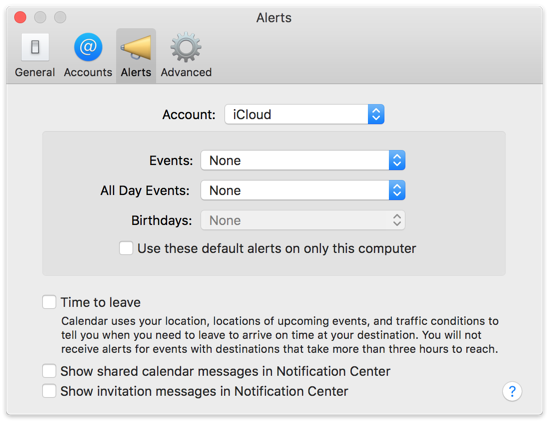Alarms
BusyCal has a flexible selection of alarms to remind you about scheduled events.
Alarms can display an alert (with or without a sound, where supported), send an email message, or open a file or app. Alarms can also be set to appear on an iOS device when arriving at or leaving a specified location. An event can have one or more alarms, each of which can occur at, before, or after the event’s start time.
Creating Alarms
To add an alarm to an event, click the “alarm” pop-up menu on the Info Panel and choose one of the default intervals from the menu.
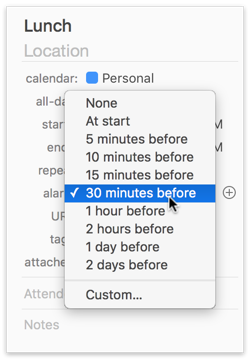
Choose Custom to set a custom interval or time for the alarm, or to specify an alarm type other than the default Message alarm.
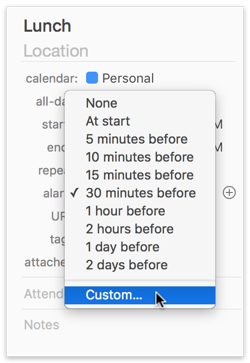
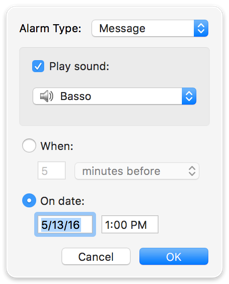
You can add multiple alarms to an event (e.g., one at 15 minutes before and another at 5 minutes before) by clicking the + (plus) icon next to the “alarm” pop-up menu on the Info Panel.
Alarm Types
In addition to the standard Message alarm, the Custom dialog enables you to create an Email alarm, Open File alarm, or Location Alarm:
- Message Alarm — The default alarm type displays an alert in the BusyCal Alarm window or in Notification Center, depending on which option you have set in Settings (see Displaying Alarms below).
- Email Alarm — Sends an email message to one of the email address listed on your Me Card. Note: Exchange accounts do not support email alarms.
- Open File Alarm — Opens an application or file, or opens a URL in your web browser. Open File Alarms run only on the Mac where they are created and do not sync with other devices, for security reasons. Note: iCloud and Exchange do not support these type of alarms.
- Location Alarm — iCloud only - Displays a geo-fenced alert on an iOS device when arriving at or leaving the todo's location (see To Dos with Location Alarms). Events do not support geo-fenced alarms.
Exchange accounts currently only support Message alarms.
Displaying Alarms
BusyCal can display alarms for events and to dos in the BusyCal Alarm window, or in the macOS Notification Center. The BusyCal Alarm window offers several advantages over Notification Center, including the ability to:
- Move and resize the Alarm window.
- Hide the window by clicking on the top left close button. To re-show the window, click on the BusyCal menu-app icon displayed in the top menu bar.
- Snooze an alarm any number of minutes, hours, or days.
- Snooze an alarm until x minutes before an event starts.
- Snooze or dismiss multiple alarms at once.
- See the color of the calendar that the event is stored on.
- Navigate the Alarm window from the keyboard.
If an event or to do item includes a location or text in the Notes field, that information (or a portion thereof) appears underneath the title of the event or to do in the BusyCal Alarm window.
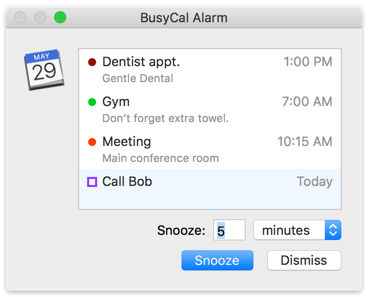
Note: When you snooze or dismiss an alarm, BusyCal must sync that action with the server in order to update the alarms on other devices that are syncing with your account. The BusyCal app must be running in order for your alarms to sync with the server, so it opens in the background if it is not already running when you snooze or dismiss an alarm.
BusyCal Alarm Window Keyboard Controls
When BusyCal’s Alarm window is active, you can do the following with the keyboard:
- Type a number to enter a snooze value.
- Type “m” to choose “minutes” from the snooze interval pop-up menu.
- Type “h” to choose “hours” from the snooze interval pop-up menu.
- Type “d” to choose “days” from the snooze interval pop-up menu.
- Type “b” to choose “minutes before start” from the snooze interval pop-up menu.
- Double-click an alarm to show the event in BusyCal.
- Select the checkbox to mark a to do as completed.
- Press Tab to toggle the selection between alarms and the snooze interval field.
- Use the arrow keys to select an alarm in the list.
- Shift-click or ⌘-click multiple alarms to dismiss or snooze all of them.
- Press Return to apply the default button (Snooze or Dismiss) to the selected alarm; or press ⌘-D to dismiss it, or ⌘-S to snooze it.
- Press Shift or Option to change the buttons to Snooze All and Dismiss All.
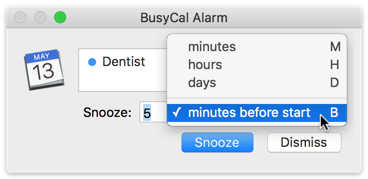
Setting default Alarm and Snooze Intervals
BusyCal enables you set different default alarms intervals for new events, all-day events, to dos, and birthdays & anniversaries.
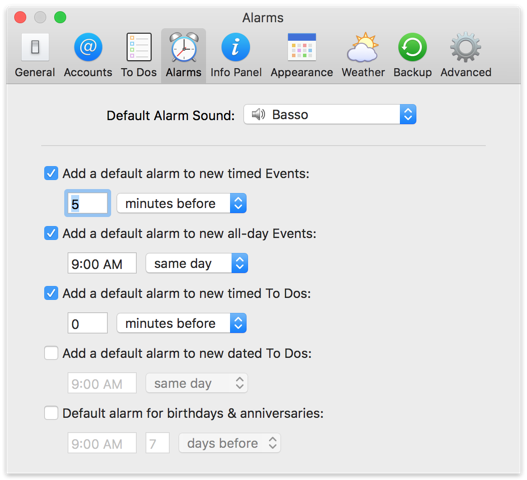
You can adjust the following settings:
- Default Alarm Sound — From this pop-up menu, choose the sound that will play when an alarm occurs.
- Add a default alarm to new timed Events — Select this checkbox to include an alarm by default when creating new timed events. Then enter a number and choose a time period (such as “minutes before” or “hours after”) from the pop-up menu.
- Add a default alarm to new all-day Events — Select this checkbox to include an alarm by default when creating new all-day events. Then enter a time and choose “same day” from the pop-up menu, or choose “days before” or “days after” and enter the number of days before or after the event’s scheduled date when the alarm should occur.
- Add a default alarm to new timed To Dos — Select this checkbox to include an alarm by default when creating new timed to dos. Then enter a number and choose a time period (such as “minutes before” or “hours after”) from the pop-up menu.
- Add a default alarm to new dated To Dos — Select this checkbox to include an alarm by default when creating new timed to dos. Then enter a time and choose “same day” from the pop-up menu, or choose “days before” or “days after” and enter the number of days before or after the to do’s scheduled date when the alarm should occur.
- Default alarm for birthdays & anniversaries — Select this checkbox to include an alarm by default for all birthdays and anniversaries. Then enter a time and choose “same day” from the pop-up menu, or choose “days before” or “days after” and enter the number of days before or after the event’s scheduled date when the alarm should occur.
Displaying Alarms in the BusyCal Alarm Window
To enable the BusyCal Alarm window, go to BusyCal > Settings > Alarms and make sure “Show alarms” is checked and “Use BusyCal Alarm window” is selected.
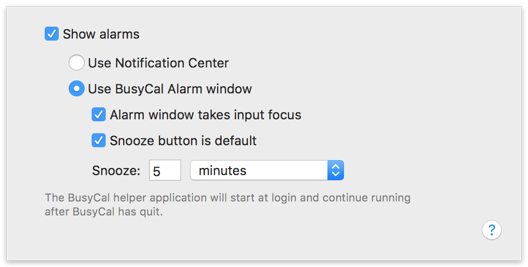
You can then select the following options:
- Alarm window takes input focus — Select this option if you want the Alarm window to take the keyboard focus, so you can snooze or dismiss an alarm from the keyboard without first having to click in the window with your pointer.
- Snooze button is default — Select this option if you want Snooze to be the default button in the Alarm window so you can press Return on the keyboard after entering a snooze value without having to click the Snooze button with your pointer. Otherwise, pressing Return dismisses the alarm.
- Snooze value — You can set a default snooze interval, including the option to snooze an alarm for x minutes before the start of the event.
Displaying Alarms in Notification Center
To receive alarms in Notification Center, choose BusyCal > Settings > Alarms, check “Show alarms,” and select “Use Notification Center.”
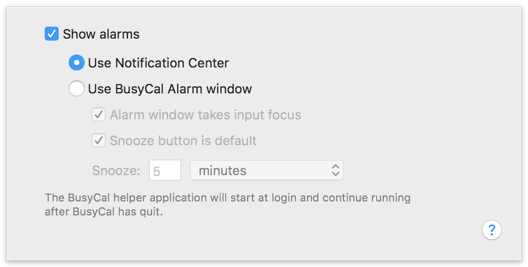
Then, go to System Settings > Notifications, select BusyCal in the left sidebar, and select your alert style and other settings.
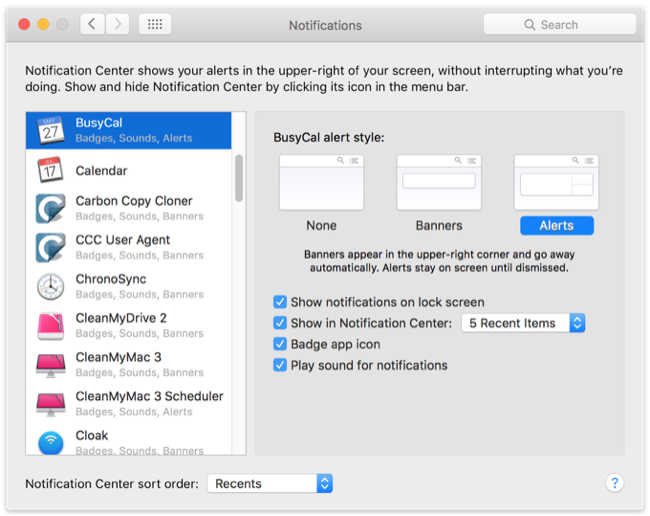
Disable macOS Calendar and Reminder Notifications
macOS Calendar, Reminders, and BusyCal can each display alarms for your events and to dos. You should disable the alerts for macOS Calendar and Reminders to prevent receiving two alarms for every event—one displayed by macOS Calendar or Reminders and another displayed by BusyCal. You can disable alerts for macOS Calendar and Reminders, as follows:
- Go to System Settings > Notifications.
- Select Calendar in the left sidebar, and then change the alert style to None or Banners.
- Select Reminders in the left sidebar, and then change the alert style to None or Banners.
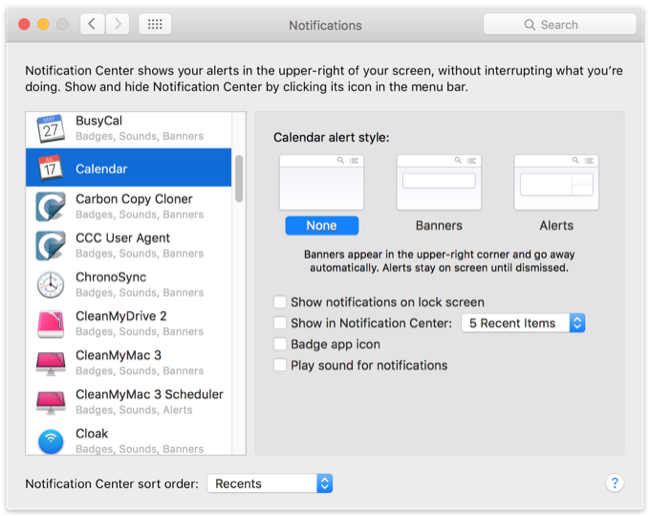
Disable Default Alarms in Calendar
macOS Calendar has a preference setting similar to BusyCal’s for setting default alarms for new events. Unfortunately, if you have that preference enabled, the Calendar app adds default alarms to all the events you create in BusyCal. Therefore, you should disable the default alarms setting in Calendar > Settings > Alerts, as shown below, to avoid extra alarms being attached to events you create in BusyCal.
